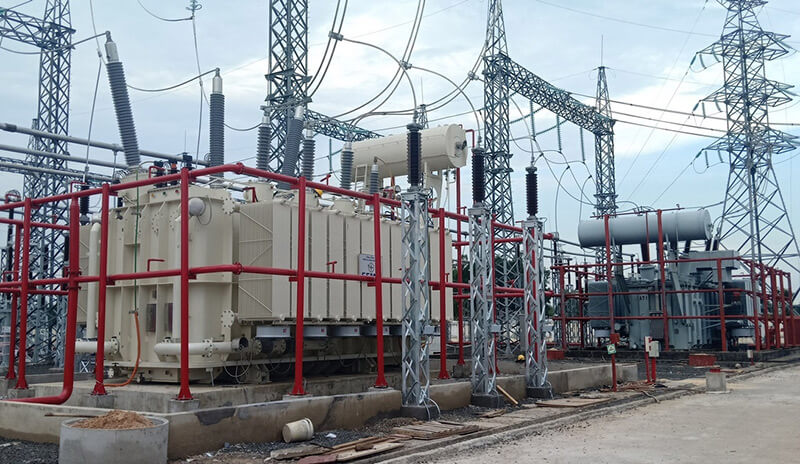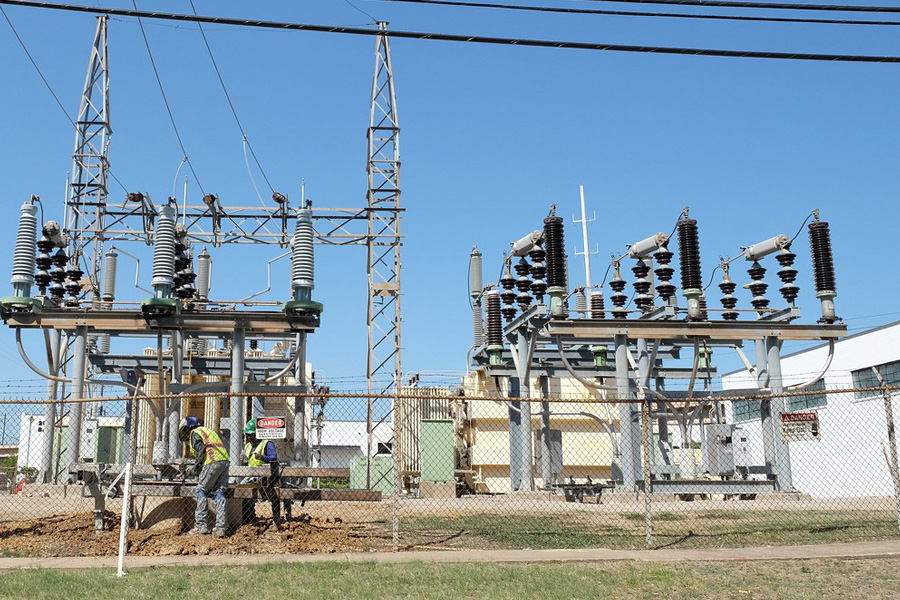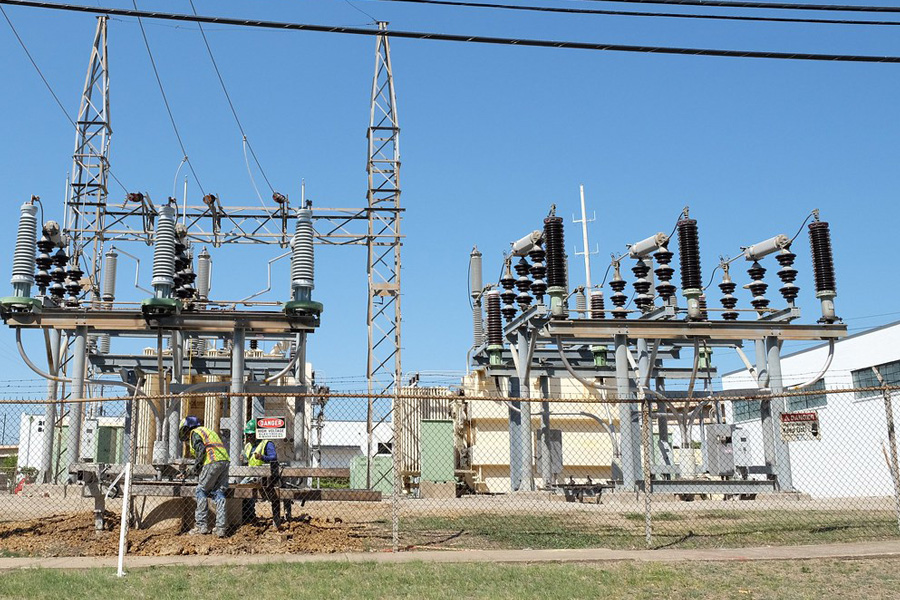General requirements for construction and installation of substations
Just like installing transformers , when installing substations, we need to pay attention to the following general requirements:
1. Preparatory work
– Based on the technical documents (requirements and detailed drawings), the technical department of the works prepares the implementation schedule.
– Make a detailed estimate of the request for equipment and materials and send it to the materials department for timely approval according to the schedule.
– Before importing materials into manufacturing, they must report to the technical department, monitoring the quality of materials to properly and fully meet the new criteria to be imported into the workshop for manufacturing.
– During the production process, the items required to ensure the specifications must be continuously monitored and checked the products and details at the end of the day.
2. Requirements for technical parts
– Study carefully the technical drawings and requirements of the investor, give common construction methods and steps in advance and receive feedback from the construction department and the material department to make corrections (if any).
– Redraw in detail the standards that need to be properly constructed and ensure technical if the bidding drawings are not clear.
– Regularly monitor and check techniques and progress throughout the construction process, promptly adjust when there are errors due to confusion or inappropriateness during the construction process.
– Static acceptance and inspection of finished products prior to pressure or coating testing.

3. Requirements of the material supply department
– Carefully study the main specifications of the required materials before requesting approval for supply.
– Carefully and fully record the parameters, origin before handing over and putting into construction.
– Regularly update equipment and supplies on price changes and domestic supply capabilities to promptly report any changes.
– Weekly inventory check with easy-to-transport small details and volume statistics when entering or leaving a full shift
4. Inquiry with the construction department
– Carefully study the technical requirements, principles, details to be fabricated and assembly drawings provided by the technical department, confirm to ensure construction assurance before signing for certification and putting into production (If there is any suspicion or suspicion of an error, it should be reported immediately to the technical department to change).
– Planning personnel and reasonable arrangement of construction force to meet requirements with products responsible for processing, manufacturing and installing.
– Absolutely comply with technical requirements, labor safety throughout the construction process.
– Regularly supervise, promptly adjust unreasonableness, monitor construction methods, constantly improve construction tools, methods and techniques to ensure assurance, aesthetics and efficiency (any Any effective improvement initiatives of employees will be reviewed and rewarded and encouraged by the Board of Directors in a timely manner).
– Write daily work progress report and suggestions if any.
Construction and installation process of transformer station
The construction and installation process of a transformer station includes the following steps:
1. Manual installation of substation
– Equipment must be moved and placed on a temporary stand (if necessary).
– Use a jack to lift the device and place the frame on a steel frame made of section steel or sheet steel combined with steel roller wheels
– Continue to raise the device and steer (turn) with the crowbar/hoist to move and place the unit on the support (foundation)
– Lower the device to the marked position
– Lift the device slightly to the head of the foundation bolt/expansion bolt on the foundation surface, adjust the height with steel plates and spacers so that the device is placed on the correct plane, then check again with a leveling machine, water pipe balance balance.
– Adjust the height of the steel frame of the device and check it with specialized equipment
– Installation of components and accessories
– Cleaning equipment and accessories
– Installation of internal cables and cable connections
– Run the cable from the outside (pre-drawn) into the electrical cabinet, check the cable for continuity and insulation, cable connector and ground
– Discharge the top of porcelain (if required)
– Add insulating oil to the auxiliary oil tank (if required)
– Protection of installed equipment and accessories such as; meter, valve, porcelain, control panel, instrumentation
– Check and mark installed equipment on the drawing. Send inspection and acceptance request to the testing and acceptance unit using the sample form
– Sanitize and transport garbage and excess materials out of the scene, keep it clean and tidy.
2. Substation main installation sequence
– Locate and find foundation landmarks
– The grounding system of the station is dug – spread – filled with soil according to the steps mentioned above.
– The transformer is transported to, then lowered to the most convenient location by crane, moving the machine to the installation position manually.
– Installation of transformers and equipment by manual or winch method note some issues:
+ While the crane must have a protective box for the machine face, not to collide with the machine surface when installing
+ When installing accessories, absolutely do not let the tools fall on the machine surface
+ When installing the beams, ensure the correct design distance
+ Install the safety ground wire, CSV ground and transformer neutral to the grounding system
– Fix the MBA to the foundation.
– Installation of equipment throughout the station
– Connect the equipment to the common grounding system
– Hanging station name signs, no climbing sign
– Calibration, testing of the whole station, making records for acceptance work.
– Connecting, energizing and handing over the works.
The transformer and equipment installed in the substation when installing the low-voltage power system need to be tested and checked to meet the operating standards before being installed. Requires skilled workers to monitor or directly install and record electrical wiring diagrams to ensure future inspection.

3. After installing the substation
– Check the position of the transformer/generator and fix it to the foundation.
– Clean and seal the cable ditch.
– Conduct testing and measurement of environmental parameters such as ventilation, lighting, etc.
– Cover and protect equipment.
4. Inspection and acceptance of the entire system
Using an insulation resistance meter, check the continuity of all conductors, ensuring the safety and aesthetics of the system. Operating system:
+ Energize the whole system in each level and in no-load mode.
+ For the system to operate in load mode (energizing the load also according to each level).
+ Fix technical errors (if any).
+ Clean the entire system.
+ Invite the state inspection agency to measure and check the conformity according to national standards to receive a license to energize the grid.
5.Testing, testing and energizing
– Check the rated parameters stated on the device label
– Overall inspection of the installation of accessories/components
– Check for damage and paint cover
– Check for oil leaks, oil level and level gauges
– Check padding of junction boxes
– Check power cables and connections
– Check equipment grounding and connections
– Check the operation of the mechanical parts of the switch and locking device
– Check breather and condition of moisture-proof particles and refill (if necessary)
– Check the protection of equipment at the scene
– Check the installation condition of the cooling fans
– Insulation test
– Insulating oil test (applicable to open-type transformers-over 100KVA) if it is an oil transformer
– High surge voltage test
– Measure the high voltage winding resistance in the highest-balanced-lowest positions of the switch
– Measure low voltage coil resistance
– Check the bolt torque on the main busbar points.
Testing and measuring equipment specifications
– Check the bolts, cable clamps… of the grounding points (if any)
– Clean and reinstall the cover (if any)
– Energize the equipment according to the manufacturer’s procedure and the high voltage system
6. Substation acceptance test
– Internal acceptance-pass
– Send a request for acceptance test to invite investors and TVGS
– Acceptance with investors and supervisors – pass
– Move to the next construction phase
Quotation for installation of 3 phase substation
The price list of low voltage substations does not include accessories and installation costs.
|
STT |
POWER SUPPLY 3P (KVA) |
Price – Tram Truss (VND) |
Unit price-Steel pillar station (VND) |
Unit price-Set box station (VND) |
|
first |
Power station 100 KVA |
288,000,000 won |
328,000,000 |
520,000,000 |
|
2 |
Power station 160 KVA |
325,000,000 VND |
368,000,000 |
560,000,000 VND |
|
3 |
Power station 250 KVA |
384,000,000 won |
438,000,000 |
620,000,000 won |
|
4 |
Power station 320 KVA |
440,000,000 won |
480,000,000 |
690,000,000 |
|
5 |
Power station 400 KVA |
468,000,000 won |
510,000,000 VND |
720,000,000 |
|
6 |
Power station 560 KVA |
558,000,000 won |
585,000,000 |
800,000,000 |
|
7 |
Power station 630 KVA |
585,000,000 VND |
630,000,000 |
840,000,000 |
|
8 |
Power station 750 KVA |
684,000,000 won |
750,000,000 |
900,000,000 |
|
9 |
Power station 1000 KVA |
826,000,000 won |
890,000,000 |
1,000,000,000 |
|
ten |
Power station 1250 KVA |
916,000,000 |
|
1,250,000,000 |
|
11 |
Power station 1500 KVA |
1,166,000,000 won |
|
1,500,000,000 |
|
twelfth |
Power station 2000 KVA |
1,366,000,000 (outdoors) |
1,550,000,000 (station house) |
|
|
13 |
Power station 2500 KVA |
1,528,000,000 (outdoor) |
1,850,000,000 (station house) |
Note: (The above quotation is for reference only. The unit price may change according to each specific case: origin of materials, installation location, type of station, …). Price does not include VAT, shipping, installation…
Customers who need advice and quotation for installation of low voltage substations, please contact our engineer team immediately for free support and advice 24/24h.
Contact us today for a free consultation and answer at:
Contact information P69 – M&E . M&E Contractor
Address: No. 6/165C Xuan Thuy, Cau Giay District, Hanoi
Website: https://p69.com.vn/
Hotline: 02437688156 – 0965937799
Email: kd@cokhip69.com.vn
Facebook: https://www.facebook.com/p69nhathaucodien
LinkedIn: https://www.linkedin.com/in/congtyp69/
Youtube : https://www.youtube.com/channel/UCOUwCnE5iGj8iqe_ZIUM7oA


